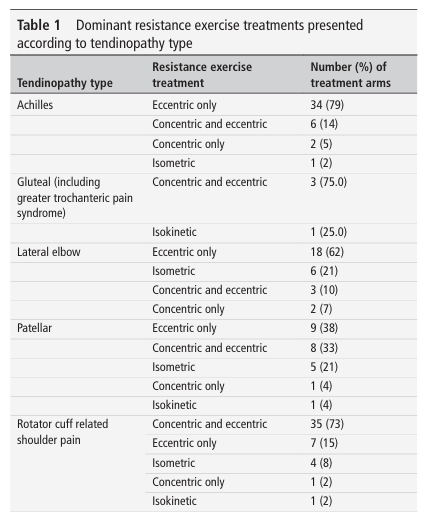Tendinopathy is a broadly defined as a painful condition occurring in and around tendons in response to overuse or under-preparation.
Resistance exercise has been shown to be effective for improving outcomes for these common tendon problems for athletes.
However, the effect of different resistance training dosing variables such as intensity, volume and frequency is not well understood.
Fortunately, a new largest-to-date meta-analysis of 110 studies across 5 common tendinopathies provides much needed insight.
How does training intensity, volume, and frequency influence tendinopathies?
What did the researchers do?
Researchers conducted a systematic review with meta-analysis and meta-regression to investigate the moderating effects of resistance exercise dosing variables, including intensity, volume, and frequency.
Training Dose Variables
- Frequency - number of training sessions performed per week
- Volume - total number of sets and repetitions
- Intensity - bodyweight vs external load in absolute or relative terms
Outcomes of Interest
- Disability
- Function
- Pain
- Range of motion for rotator cuff-related shoulder pain (RCRSP)
- Physical function capacity
- Quality of life
Included in Study
- 110 studies were included across
- 148 treatments arms
- 3,953 participants
- 5 tendinopathy types

What did they report?
- Higher-intensity resistance training showed consistent evidence of greater pooled mean effect sizes when additional external resistance was used compared with body mass only.
- Lower frequency had greater efficacy, implying benefits of adequate recovery, compared with higher frequencies of once or more per day.
- Training volume pooled mean effect sizes were minimal and inconsistent.
What does this mean?
- Higher intensity using external loads versus bodyweight alone appears to be better.
- Frequencies spread across the week with off days appear to be better than every day or multiple times per day.
- Effect of volume was unclear, given that majority of studies used similar volume of 3x15.
Worth Noting Limitations
- Exercise dose across studies is poorly reported, making firm conclusions challenging.
- Intensity was binary categorized as bodyweight or above bodyweight
- Muscle actions were not differentiated between eccentric, isometric, and concentric.
Coach's Takeaway
- The use of an external load greater than body weight should be prescribed for tendon pain, assuming the pain is tolerated well.
- Using less frequent but higher-intensity sessions with adequate recovery time allows for greater stimulus-recovery-adaptation cycles compared to daily or multiple sessions per day.
- As intensity is progressed above bodyweight, start with a high-low or on-off cycle and adjust based on the athlete's response.
I hope this helps,
Ramsey




